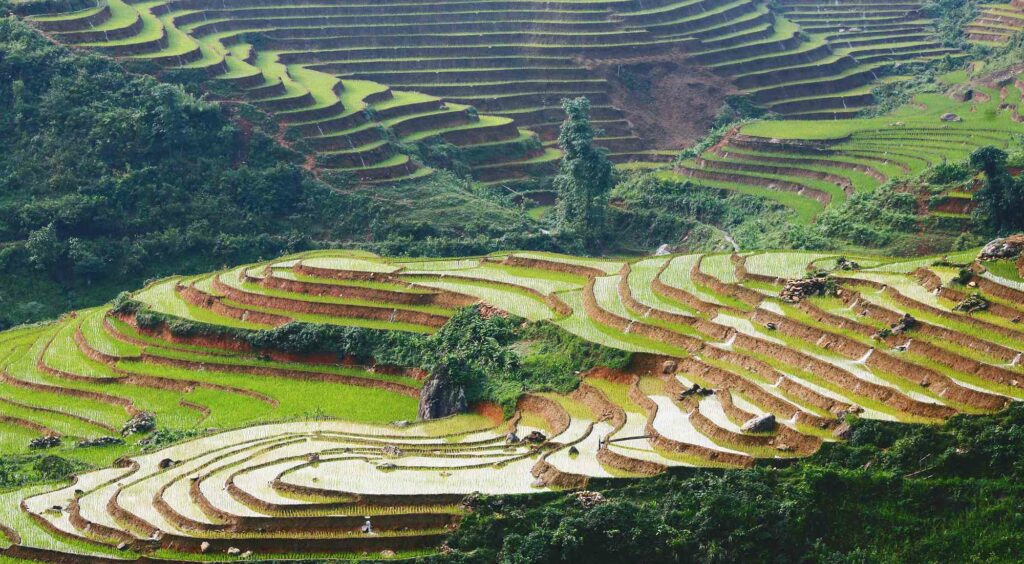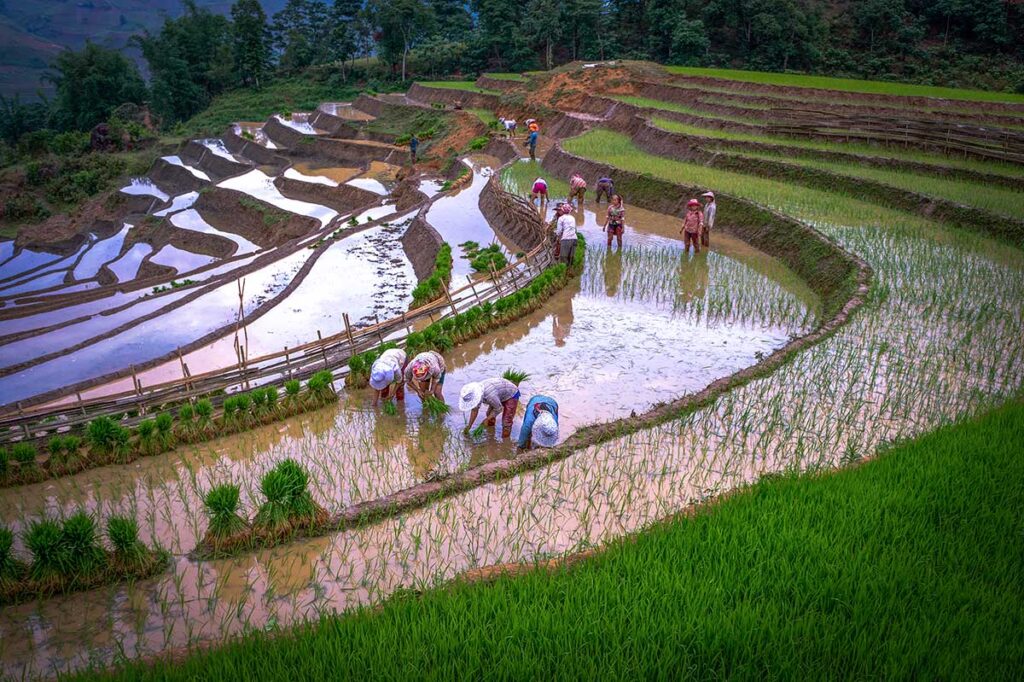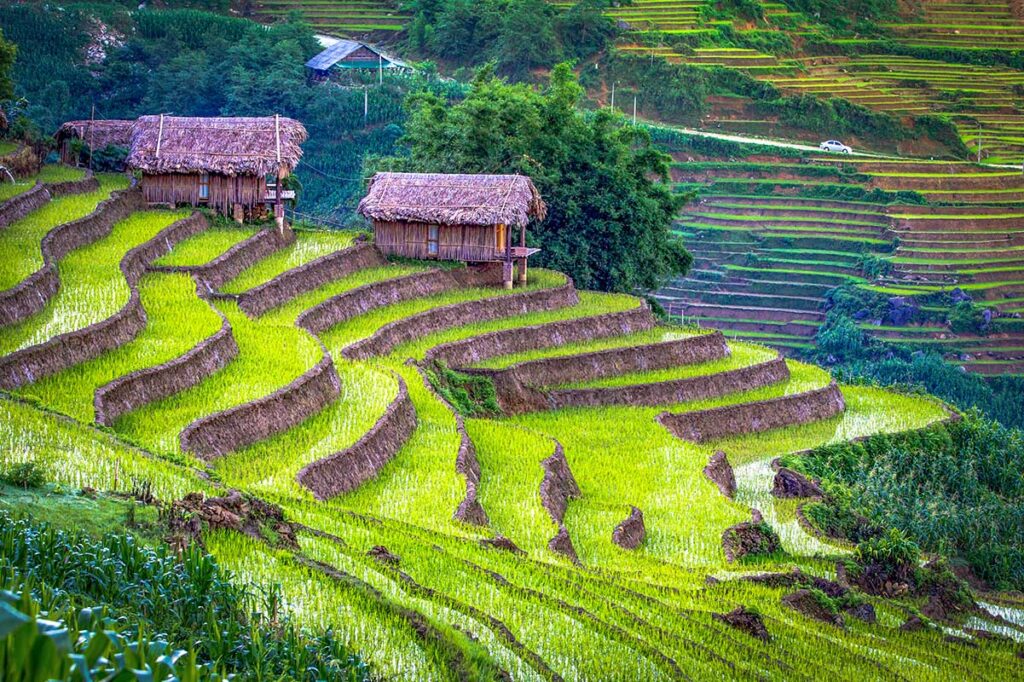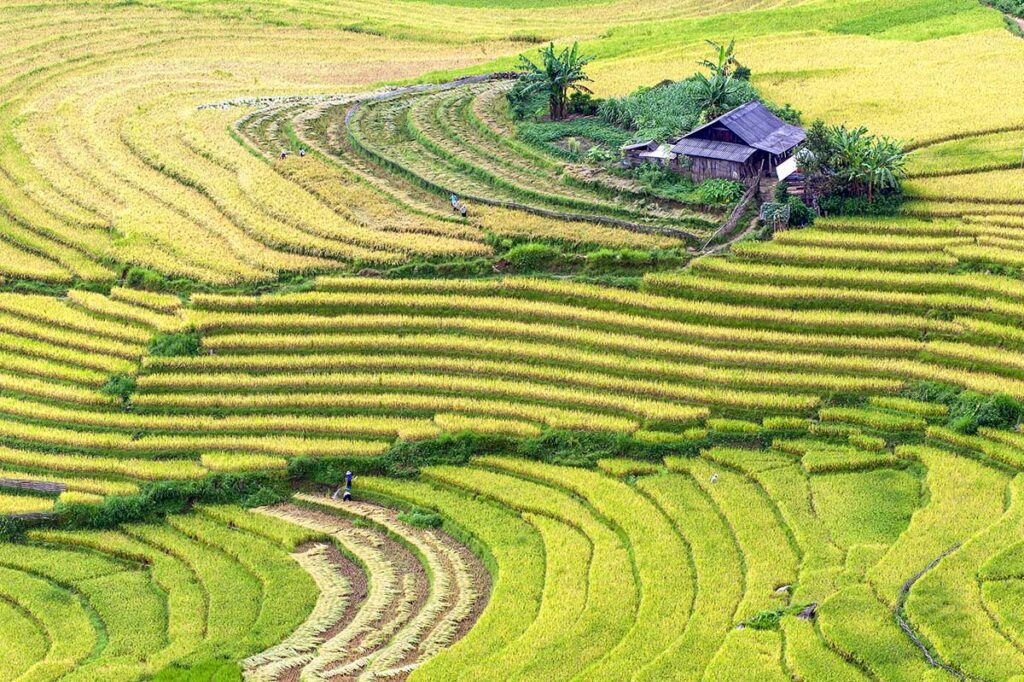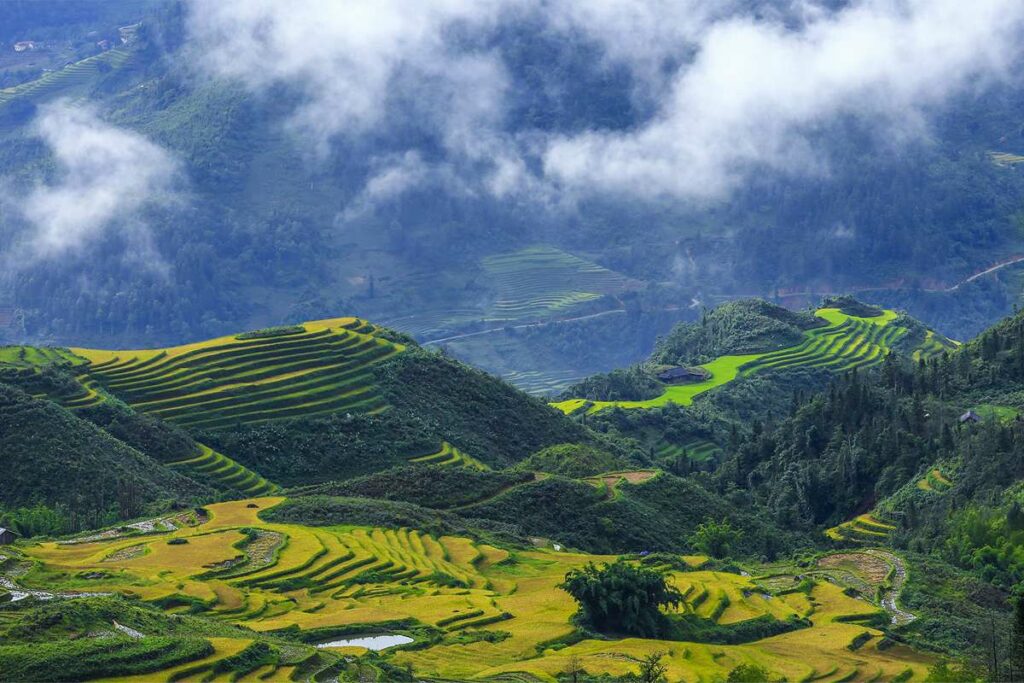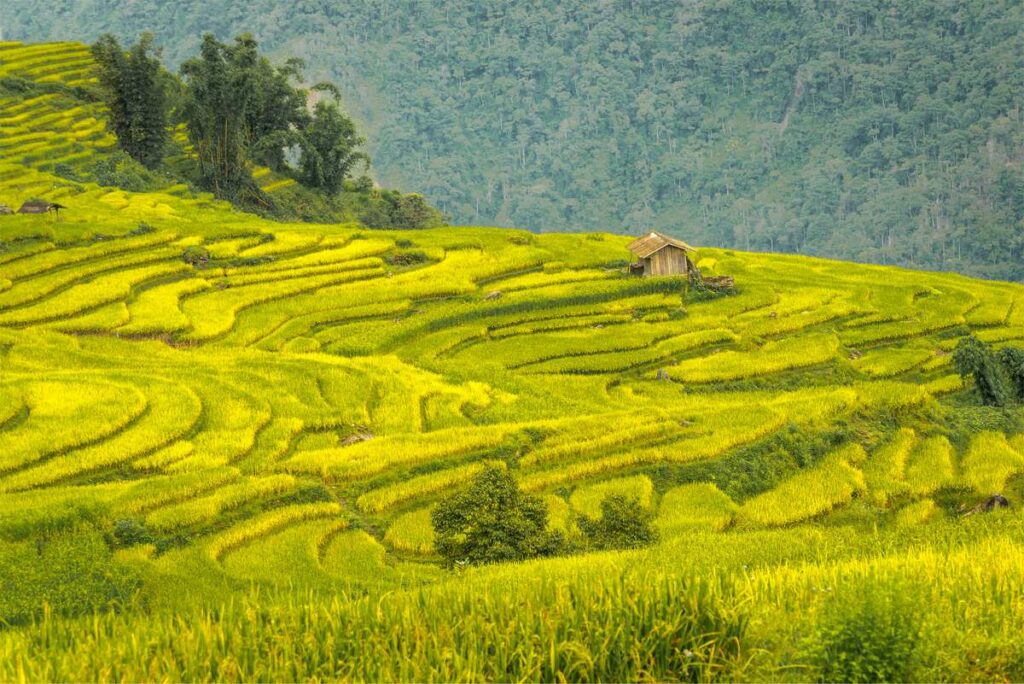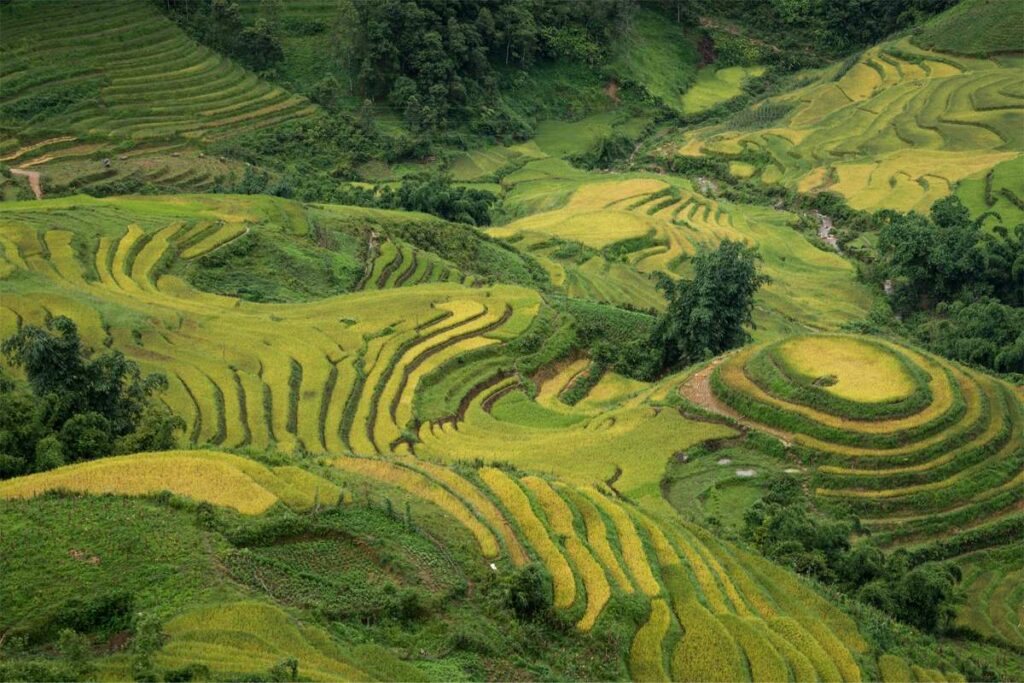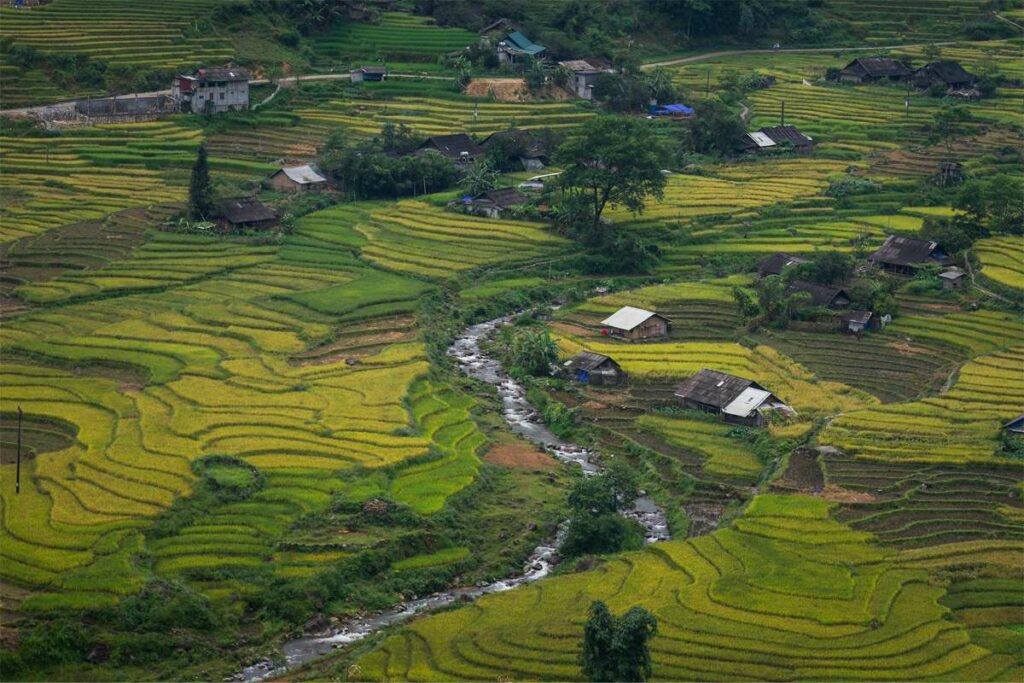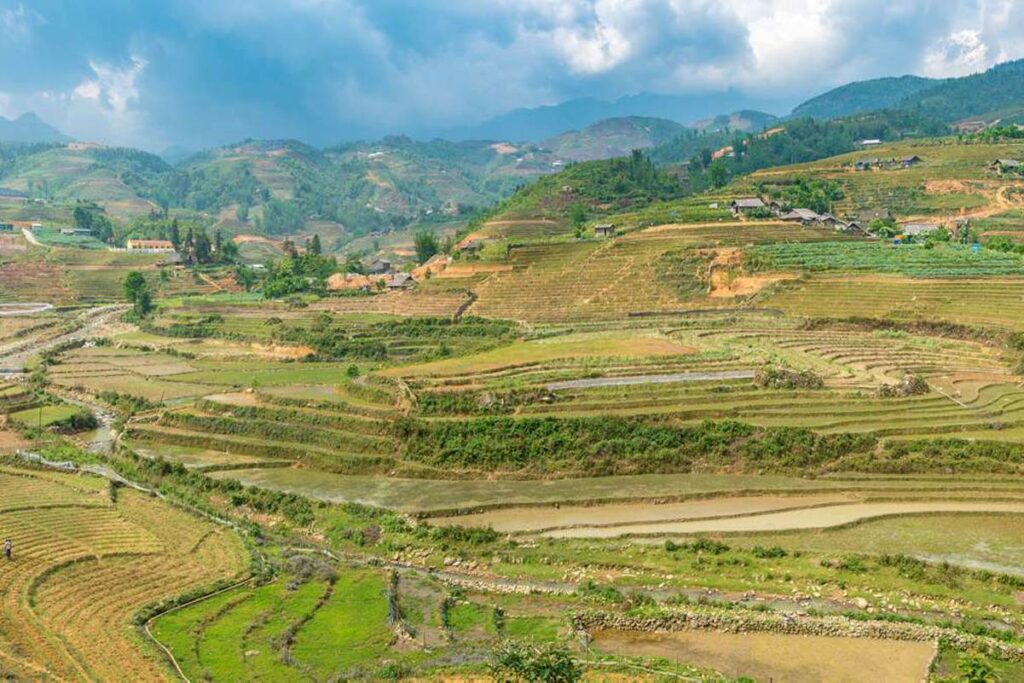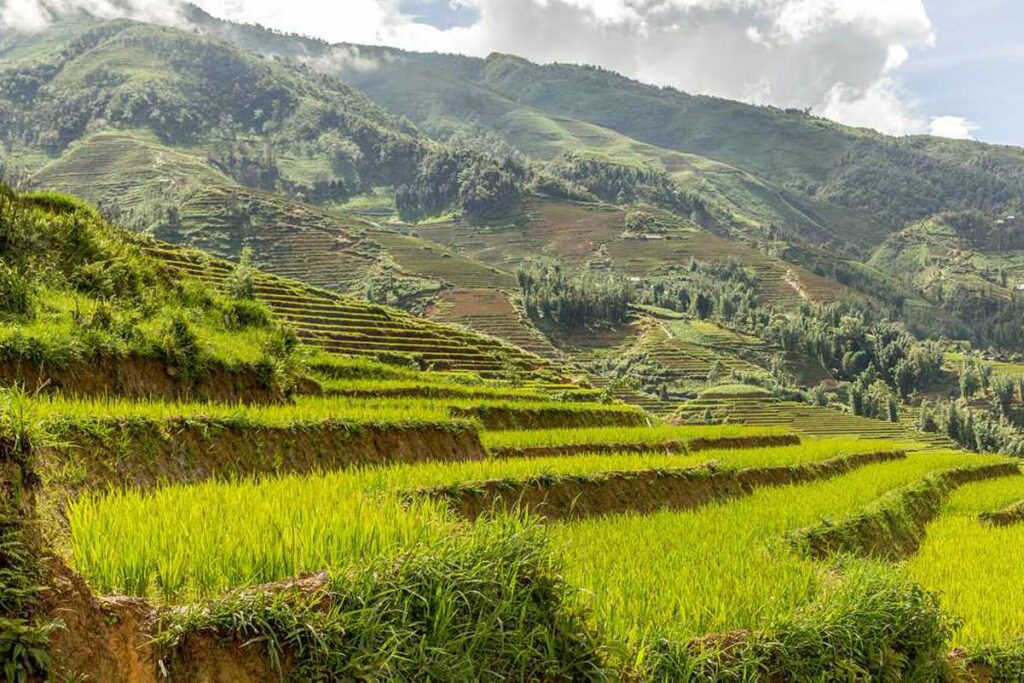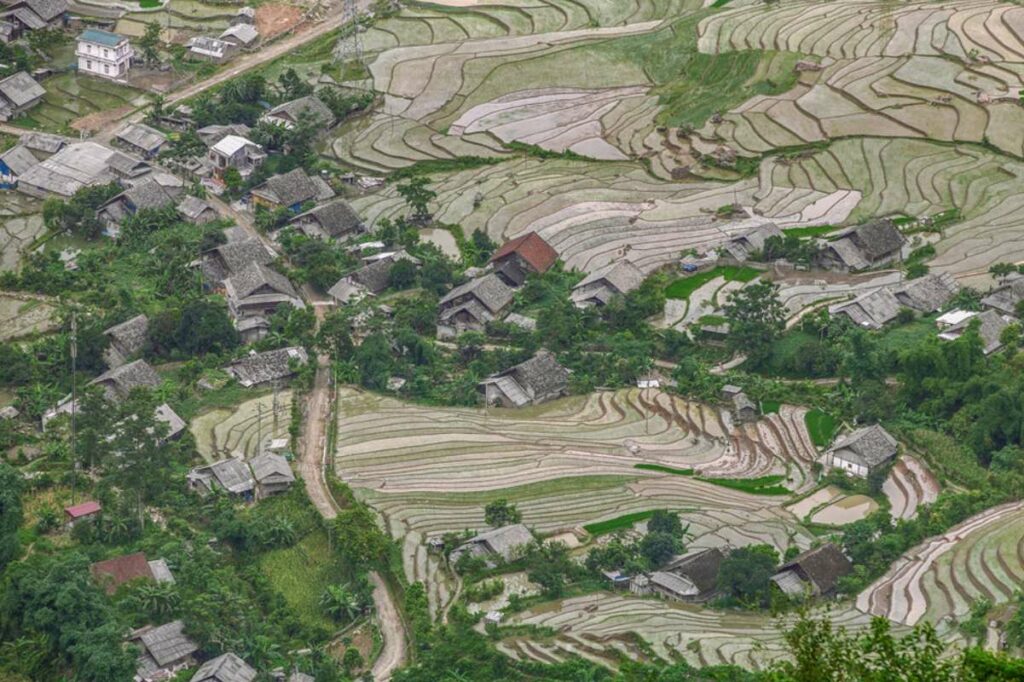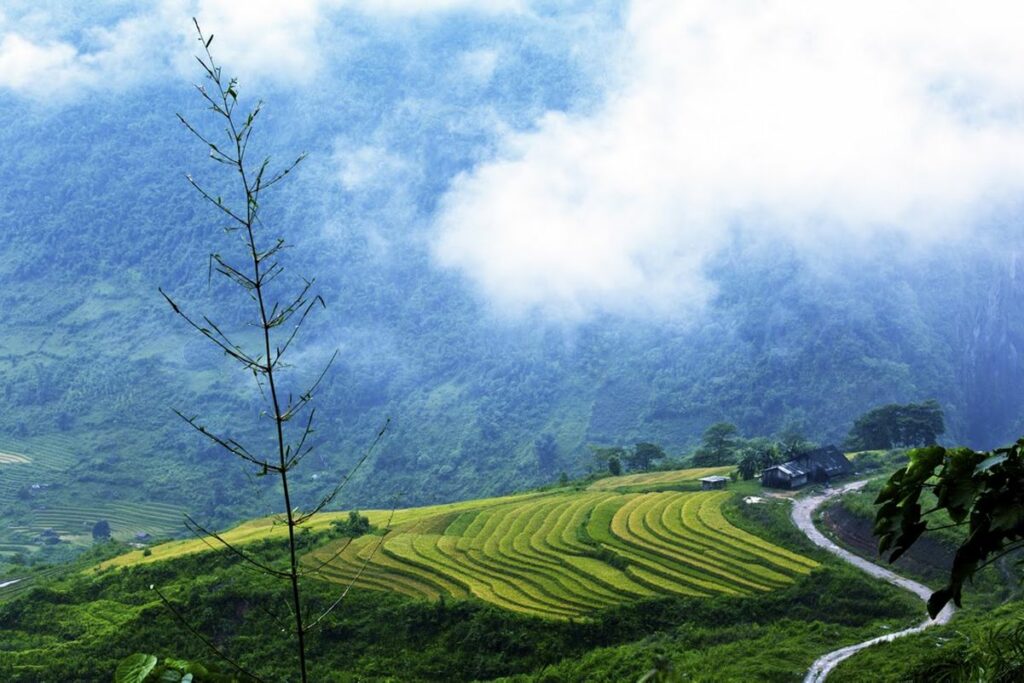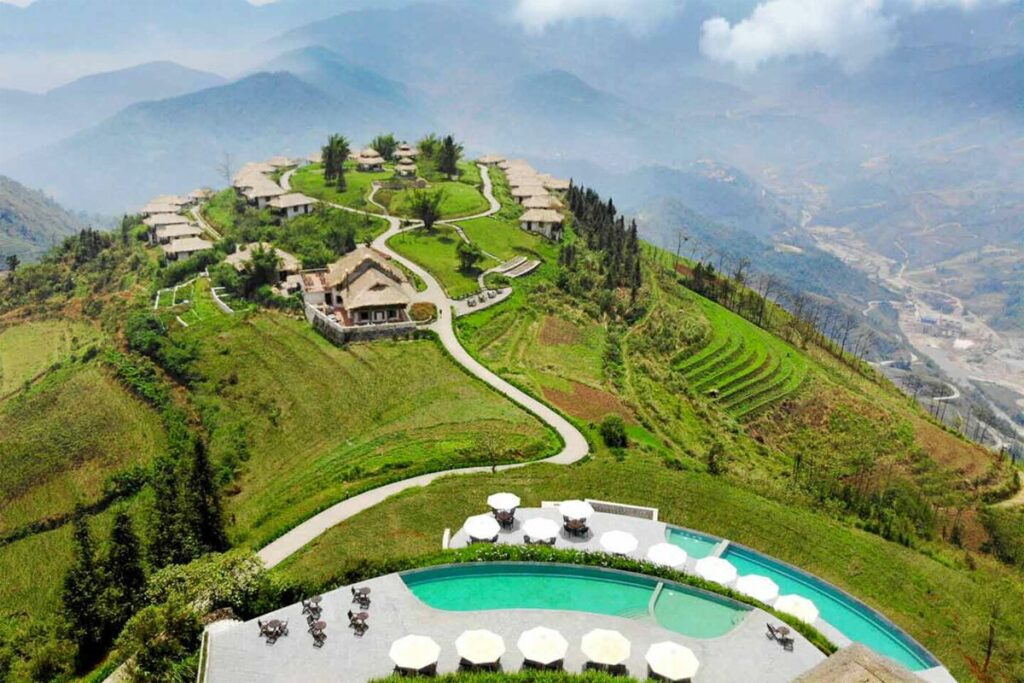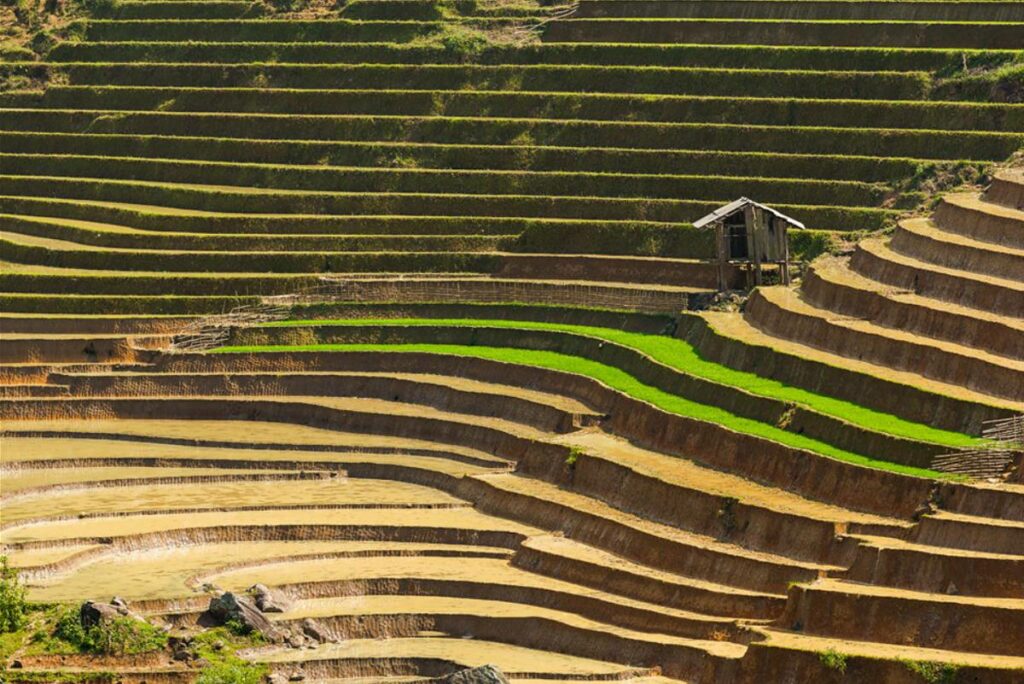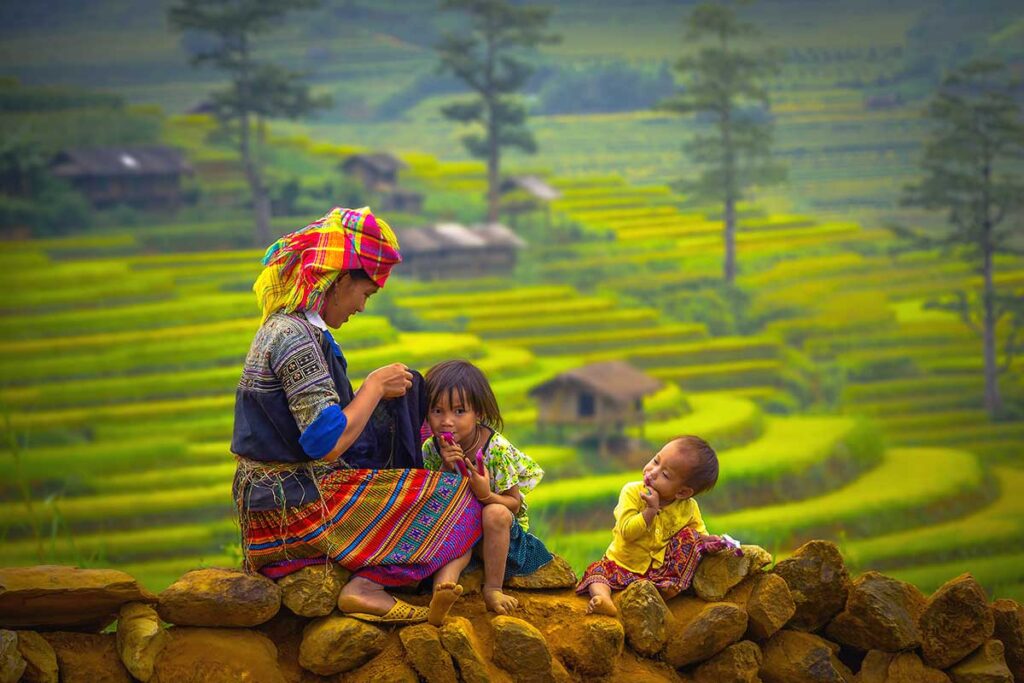Best time visit the Sapa terraced rice fields
The Sapa rice fields you see in photos—lush green terraces or glowing golden hills—don’t look like that year-round. Rice needs a lot of sun and water to grow, and in the high mountains of northern Vietnam, water is harder to manage. That’s why, unlike the lowlands in Vietnam which may have two rice crops per year, Sapa usually has only one. This makes timing your visit essential.
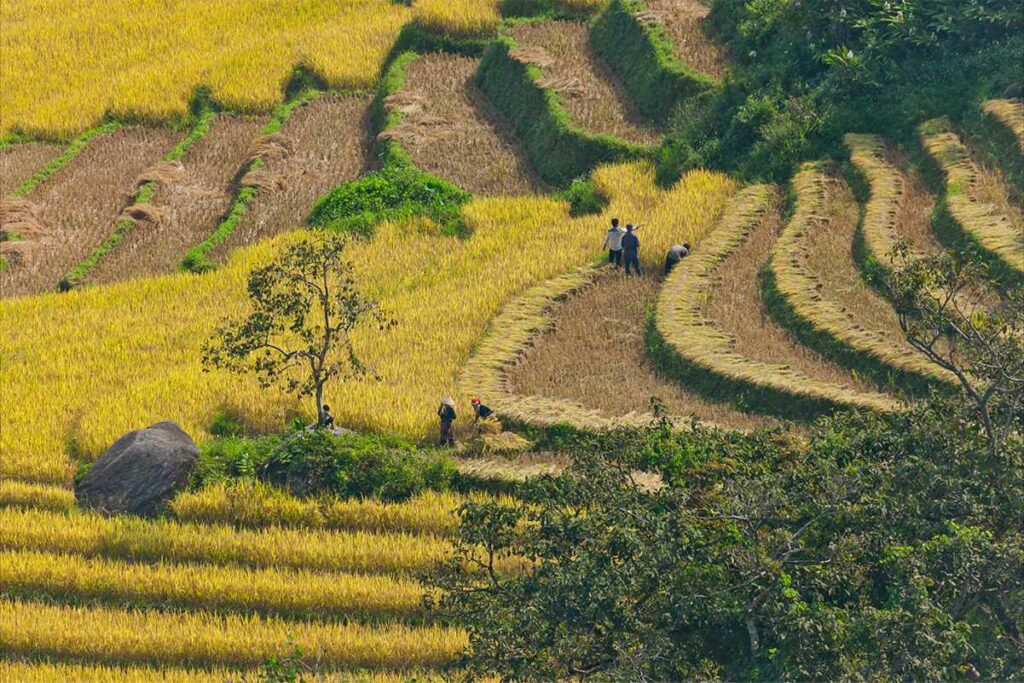
Below you’ll find an overview of how the rice fields change throughout the year, when to expect the best views, and how the weather affects your trip.
April / May – Flooding & Plowing
The start of the rice season. Fields are filled with water, creating a shimmering mirror effect—one of the most visually stunning times for landscape photography. You’ll see buffaloes and local farmers preparing the terraces.
June – Early Growth
Young rice begins to sprout, sticking out of the water. Fields still reflect the sky, but now have soft green textures from the baby rice plants. A beautiful transition period with fewer crowds.
July – Lush Green Fields
Rice grows quickly this month. The further into July, the greener and taller the rice becomes. By the end of the month, the fields are full and vibrant—ideal for scenic views and trekking.
August – From Green to Gold
One of the most photogenic times. Early August features deep green terraces, while mid to late August brings the first golden hues as the rice matures. Expect a mix of color and activity as locals prepare for harvest.
September – Harvest Time
Golden fields at the start of the month, with active harvesting in progress. The scenery is dramatic and dynamic. However, by the end of September, most terraces are harvested and begin to lose their visual appeal.
How to explore the Sapa rice fields
The best way to experience the Sapa rice fields is to get out into them—walking between villages, enjoying the fresh air, and meeting the ethnic communities who live among the terraces. Whether you’re up for a multi-day trek or prefer to explore by motorbike or car, there’s an option for every kind of traveler. Here’s an overview of the best ways to explore the rice fields of Sapa.
1. Trekking through the rice fields
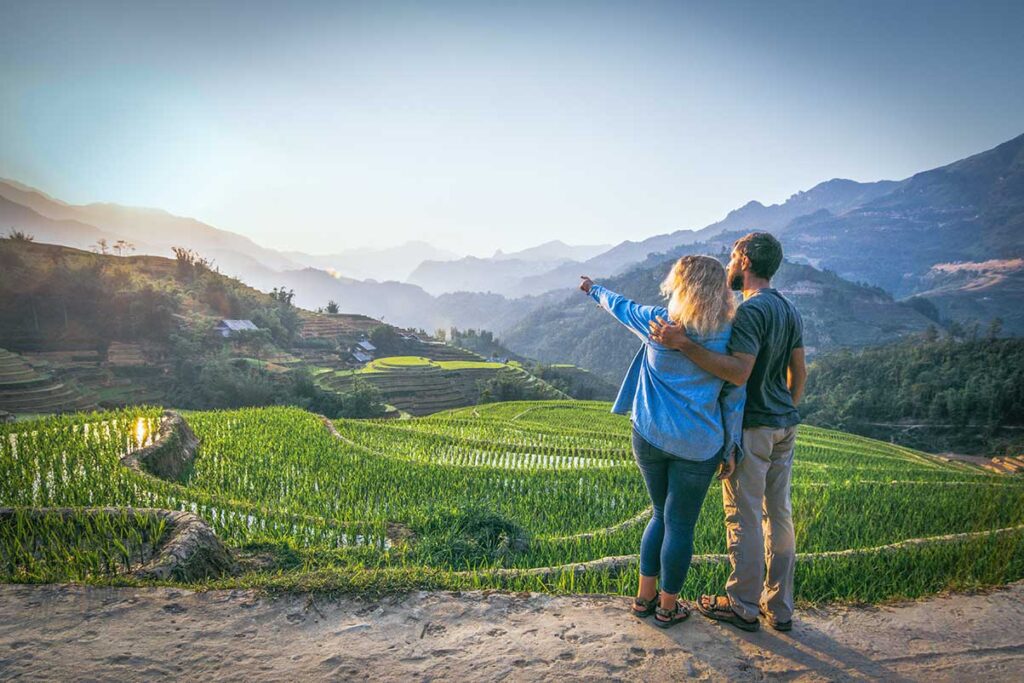
Trekking in Sapa is the most immersive way to explore Sapa. You’ll walk through terraced fields, cross small streams, and visit minority villages like Ta Van, Lao Chai, or Ban Ho. Treks range from short half-day walks to multi-day routes with overnight stays in local homestays (see more: homestays in Sapa).
You can go on your own, but hiring a local guide is strongly recommended. Guides not only ensure you stay on the right paths, but also help you connect with the local culture and understand daily life in the mountains.
Tip: Many of our Sapa tours include guided trekking combined with homestay experiences.
2. Exploring by Car
If you’re not able or not interested in trekking, hiring a car with a driver is a great alternative. From the Muong Hoa Valley road, you’ll have excellent views of the rice terraces while driving. The car can stop in villages that are easily accessible, allowing you to explore without long walks.
Tip: Want to explore by car? We can arrange a private driver for your Sapa trip.
3. Exploring by Motorbike (Self-Drive)
For experienced riders, motorbikes offer freedom and flexibility. The main road through the Muong Hoa Valley is relatively easy to drive and very scenic. From there, smaller dirt roads branch off to more remote villages—but only skilled and confident drivers should attempt those.
Be cautious: road conditions change quickly, especially in the rainy season. Mountain roads can be steep, narrow, and slippery.
You can drive the Sapa Loop if you are really into motorbike driving. The loop takes 2 to 3 days, but keep in mind that driving through the mountains of Vietnam is not without danger and only meant for experience drivers.
4. Easy rider motorbike your (On the back)
Not comfortable riding yourself? Join a local motorbike tour, where you sit on the back with an experienced guide. It’s a safer way to explore lesser-known routes, and your guide will know the best photo spots, shortcuts, and cultural insights.
This option combines the adventure of a motorbike with the ease of not having to worry about directions or road safety.
Bonus: Hotels with rice field views
You don’t even have to leave your room to enjoy the beauty of Sapa’s rice terraces. While most hotels in Sapa town have no view of the rice fields, those located along the Muong Hoa Valley offer spectacular vistas. Some lodges and bungalows are perched right at the edge of the fields—perfect for sunrise views with your morning coffee.
Check out our full guides to the Best hotels with a view in Sapa and the Best lodges and resorts with rice field views.
Best Sapa rice fields (areas and locations)
The best rice fields of Sapa can be found in the Muong Hoa Valley. The whole valley is covered in paddy fields, but to guide you around, we listed a few villages and communes to indicate where the best places are to view them.
1. Y Ty
For the most beautiful rice fields around Sapa you have to travel the farthest. Around 75 km or 3,5 hours to be more precise. Y Ty is located high in the mountains, close to the Chinese border. Because of a height of more than 2000 meter, it is often covered in clouds. Because of the distance it is not visited by many tourist and manly known under the photographer community. The reason for that is obvious, in this commune the terraced rice fields are enormous and high, interspersed with remote villages of ethnic minorities.
2. Ta Van
Ta Van village is one of the more known villages around Sapa and a popular place to stay overnight in a homestay. The popularity is because this village is completely surrounded by the rice fields of Sapa. Staying overnight here is a unique experience.
3. Ta Phin
Ta Phin village is another village located in the Muong Hoa Valley, surrounded with rice fields. It is around 15 km from the center of Sapa. There are many trekking tours to this village, with enough homestays for an overnight stay and surrounded by the famous rice paddy fields.
4. Ban Ho
Ban Ho is with 32 km from Sapa and because it is located deeper in the Muong Hoa Valley, it is also a less visited village. There are two day trekking tours that end here and some 3 day trekking tours stay here overnight (at the second night). There are great trekking trails between Ta Van and Ban Ho, but it is wise to do this with a guide, as the trails are not indicated on online maps. On the way you can spot some stunning rice fields.
5. Thanh Kim
At Thanh Kim you can find Topas Ecolodge, the most famous eco lodge of north Vietnam. Enjoy the infinity pool on top of the mountain with a scenic view on the rice fields below. Bungalows are dotted along the mountain side with similar views. But there is a high price tag for staying in this resort and if it does not fit in you budget, you can still explore the Thanh Kim area and enjoy the views.
How are the Sapa rice fields built?
The Sapa rice fields are not only breathtaking to look at — they are an incredible example of human adaptation to nature. These terraced fields were carved by hand into steep mountainsides to create flat, water-retaining surfaces for growing rice. Water is directed from mountain streams through hand-dug channels, flowing gently from one level to the next. This traditional technique helps prevent erosion and makes rice cultivation possible even on rugged terrain.
Many of these terraces were built over 100 years ago and continue to be used today. The people behind this impressive feat are the region’s ethnic minorities, mainly the Hmong, Dao, Giay, and Tay communities. The knowledge of building and maintaining these terraces has been passed down through generations.
When you visit the Sapa rice fields, you’ll often see local farmers working in the fields using simple tools and buffaloes. During planting and harvest seasons, many still wear their traditional clothing and work entirely by hand — a living tradition that connects Sapa’s landscape with its cultural heritage.
Tips for visiting the Sapa rice fields
Make the most of your experience in the Sapa rice fields with these essential tips. From responsible behavior to practical preparation, each one helps you explore the landscape respectfully and comfortably.
1. Be Respectful — Don’t step into the rice fields
The rice fields may look like the perfect photo backdrop, but they’re not just scenery — they’re the livelihood of local farmers. Stepping into the fields can damage young rice plants or break the fragile mud walls that hold water. Always stay on marked paths or walkways, and avoid walking along narrow terrace edges.
2. Go with a local guide
Hiring a local guide transforms your visit. They know the safest and most scenic trails, explain the farming techniques and customs you see, and help you interact with local villagers. Many guides are from ethnic minority groups themselves and offer an authentic, insightful experience beyond the main tourist routes.
Note: Check out our Sapa tours — from multi-day treks with overnight stays to easy half-day hikes. All tours are guided by locals from the region and can be customized to your interests and fitness level.
3. Wear proper footwear and bring essentials
Trails around the rice fields can get muddy, especially during or after rain. Wear good walking shoes or trekking boots with grip. For day hikes, bring water, a hat, sunscreen, and a light raincoat. Even short walks can involve uneven or slippery terrain, so be prepared.
4. Try a real ethnic homestay — Just for one night
Staying with a local family in the heart of the rice fields is one of the most memorable ways to experience Sapa. These traditional homestays are simple — think thin mattresses, shared bathrooms, and no luxury — but they offer a rare glimpse into local life. You’ll eat home-cooked meals, see the tools they use on the land, and wake up surrounded by rice terraces.
5. Bring cash with you
If you’re trekking or staying in villages like Ta Van or Lao Chai, bring enough cash. Most homestays, guides, and small cafés don’t accept cards, and ATMs are only available in Sapa town — which might be far if you’re deep into a trekking route. Bring small notes for meals, drinks, and local handicrafts.
6. Visiting outside the main season? It can still be worth it
The best time to see the Sapa rice fields is during the growing and harvest months, but that doesn’t mean off-season visits are pointless. In winter (Dec–Feb), the fields are dry, but the valley is quiet, the air is crisp, and you’ll still enjoy stunning mountain views and cultural encounters.
Spring (March–April) brings fresh greenery and blooming flowers before the fields are planted again. If you’re more interested in trekking, photography, or meeting locals than seeing golden rice, it’s still a rewarding trip.
Other terraced rice fields in Vietnam
Are the rice fields in Sapa too far from your planned route? Or do you prefer more off the beaten track, without many tourist visiting? Then there are still plenty of alternatives to Sapa.
- Mu Cang Chai – Here you will find the most stunning rice fields of Vietnam. It is mostly visited during harvest season, because it lacks of other sights compared to Sapa. It also has some of the best options for trekking in Vietnam.
- Hoang Su Phi – This is almost as off the beaten as you can find. Far away for any tourist hot spot, in the province of Ha Giang you will find some of the most epic rice fields in combination with authentic villages of ethnic minority.
- Pu Luong – This nature reserve is further south, between Mai Chau and Ninh Binh. It is smaller than the rice fields in Sapa, but also more quiet and picturesque. here you can find a valley full of terraced rice fields with small villages. Perfect trekking destination.
